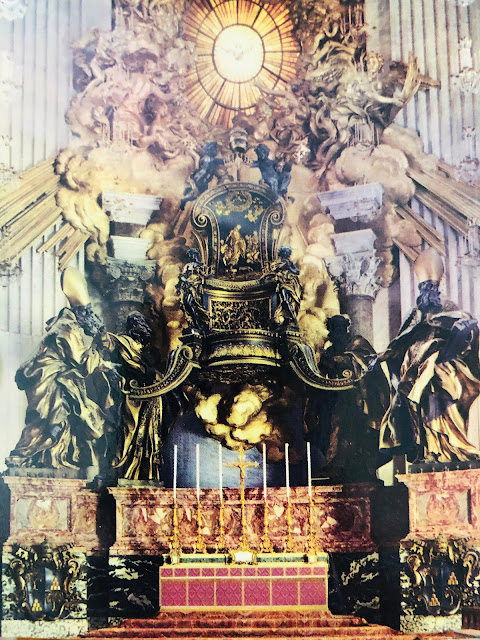The altar depicted in the photo was placed here in St. Peter's Basilica during the reign of Pius IX and was removed by order of the Rev. Fabbrica di San Pietro in 1994. The various candlesticks are on display today in the Treasury Museum of St. Peter's Basilica, located next to the Sacristy.
It can safely be said that what happened at St. Peter's violated the liturgical norms in place at that time. A very well known 1967 document on the Eucharist has this to say:
"Care should be taken against destroying treasures of sacred art in the course of remodeling churches. On the judgment of the local Ordinary, after consulting experts and, when applicable, with consent of other concerned parties, the decision may be made to relocate some of these treasures in the interest of the liturgical reform. In such a case this should be done with good sense and in a way that even in their new locations they will be set up in a manner befitting and worthy of the works themselves" (cf. Eucharisticum Mysterium, 24).
The inscription commemorating its consecration can clearly be seen carved on the front of the altar, in simplex style.
Nevertheless, the tragic affair of the Vatican Basilica is a reality and it resulted no doubt from a typical and erroneous interpretation of Vatican II (big surprise), which of course said absolutely nothing about removing altars or permanently disfiguring historic places of prayer like St. Peter's. Nevertheless, the removal or destruction of the old altar stands as an unfortunate abuse of power and a prime example of poor judgment, potentially subject to censure. It should not have happened and absolutely cannot be justified with an appeal to Church documents of the time. Although the Code of Canon Law does not attain this level of specificity in its treatment of altars (can. 1235-1239), the above passage taken from Eucharisticum Mysterium represents a universal liturgical law and its violation is thus forbidden.
Perhaps as a direct result of abuses of recent decades, the latest edition of the General Instruction of the Roman Missal (2002) includes a revision that is particularly relevant:
"In building new churches, it is preferable to erect a single altar which in the gathering of the faithful will signify the one Christ and the one Eucharist of the Church. In already existing churches, however, when the old altar is positioned so that it makes people's participation difficult but cannot be moved without damage to its artistic value, another fixed altar, of artistic merit and duly dedicated, should be erected and sacred rites celebrated on it alone" (cf. GIRM, 303).
Let us hope and pray for authentic renewal in the Church. I encourage the discussion to bring this interior sanctuary back to to a poetic conception with a high altar that rescues it from the danger of bleak commonplaceness. We are made for the heights of nobility - we need to build a world where we all know this. Below is what the altar looked like in 1666 when it was dedicated. We pray for a restoration.
Following below is a press photo image of Cardinal Spellman celebrating Mass in 1957 on the since vanquished altar.


















.jpg)








